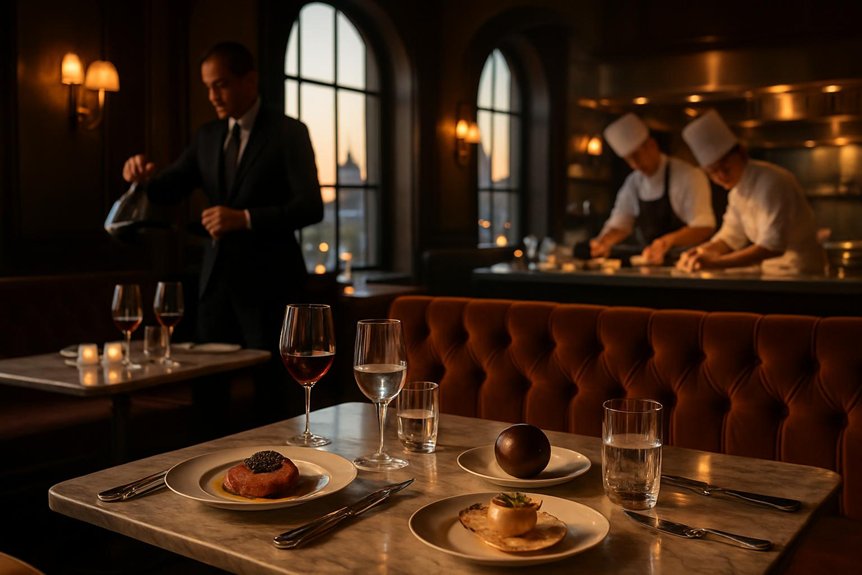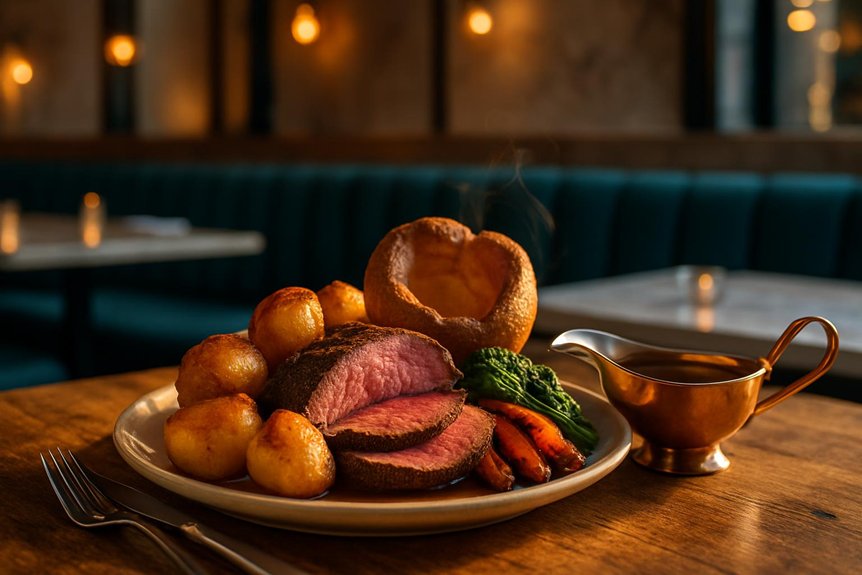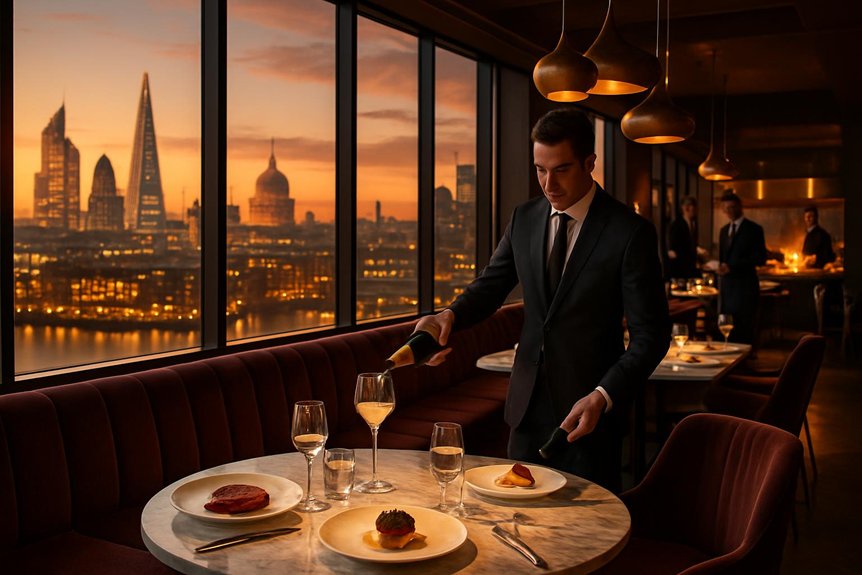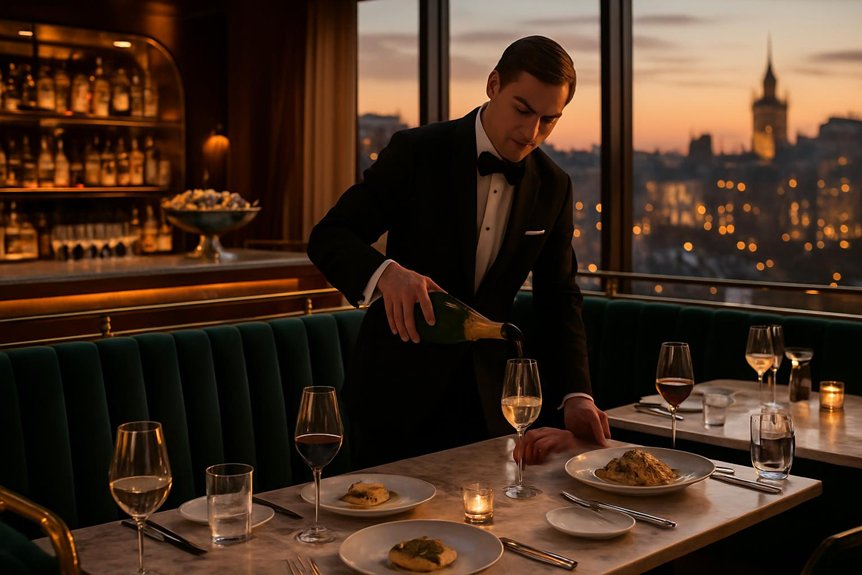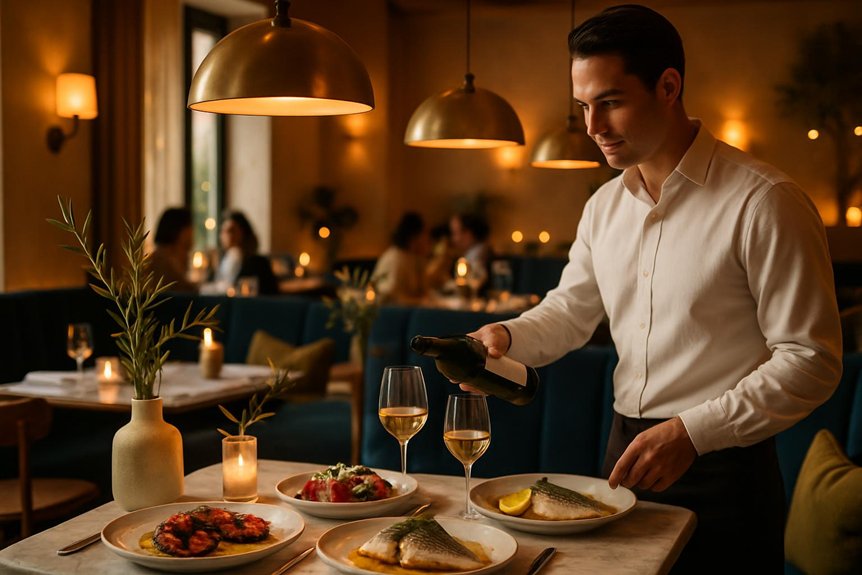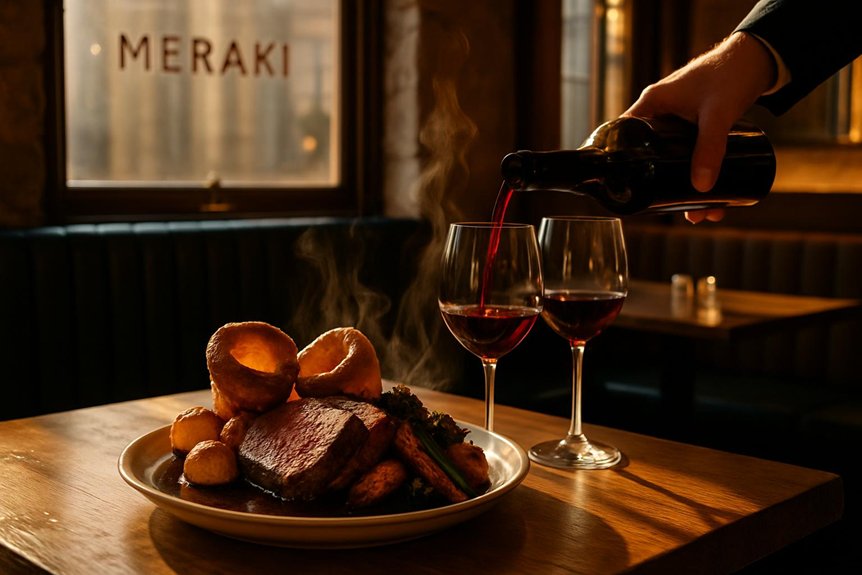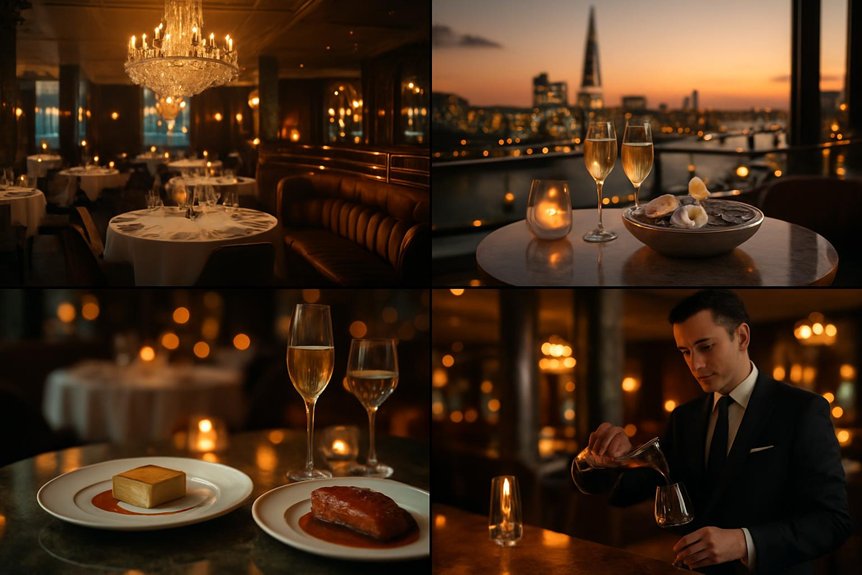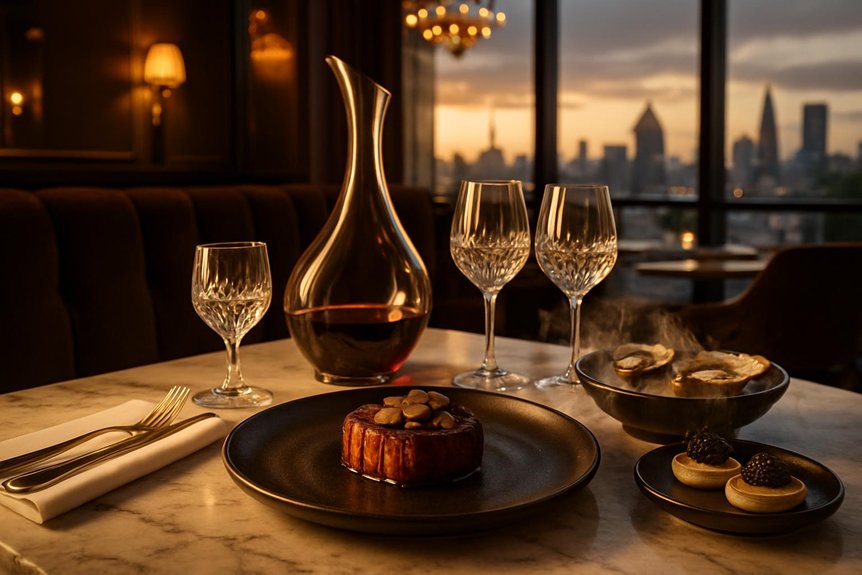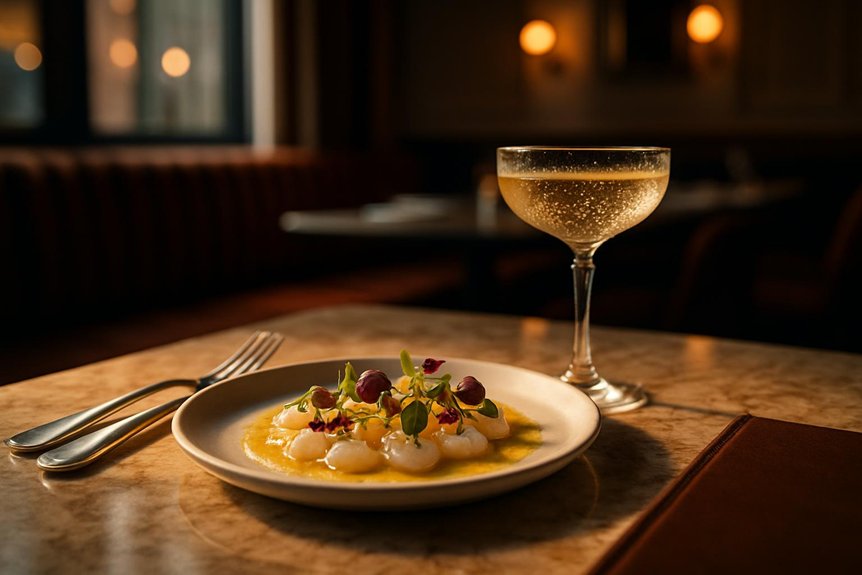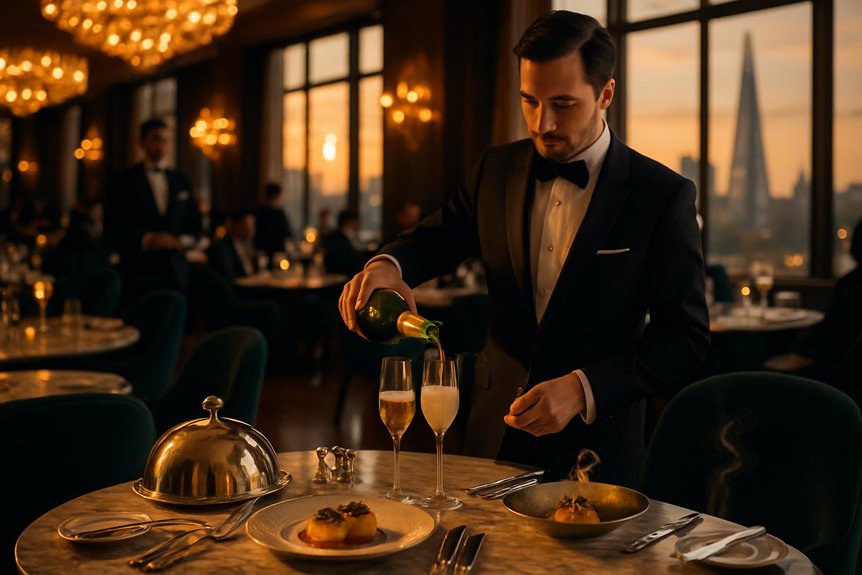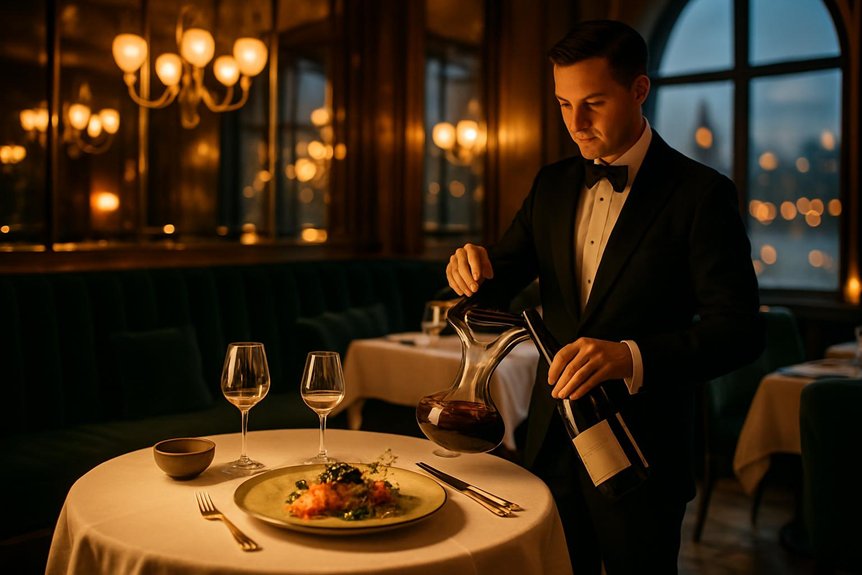London’s highest echelons of dining balance heritage and modernity with quiet precision. Menus champion British produce, refined technique, and polished service. Tasting formats meet curated wine programs, guided by discreet sommeliers. Interiors mix historic bones with contemporary lines, while table-side rituals add nuance. From Mayfair legends to Knightsbridge sanctuaries and chef’s counters, each room signals restraint and intention. The question is not where to go, but which experience defines luxury now.
Michelin-Starred Icons in Mayfair
How does Mayfair sustain such a dense constellation of Michelin stars within a few square blocks? The district’s appeal lies in uncompromising technique, discreet service, and menus that balance classical rigor with contemporary clarity. Chefs anchor tasting courses in locally sourced British produce—day-boat fish, heritage meats, and market vegetables—integrated through sustainable practices that now shape both procurement and waste reduction. Wine programs emphasize depth and precision, pairing aged Bordeaux with seasonal plates while spotlighting grower Champagne. Dining rooms project restraint: polished wood, muted palettes, exacting acoustics. Lunch tasting menus draw financiers; late services attract collectors and art-world patrons. Reservations are strategic, kitchens tightly choreographed, and standards enforced nightly. Mayfair’s Michelin cluster endures because excellence here is procedural, data-driven, and relentlessly audited. Meraki Luxury Restaurant exemplifies this dedication to high-end dining, offering a relaxed yet refined experience inspired by Greek cuisine.
Knightsbridge Temples of Gastronomy
Knightsbridge presents a cluster of Michelin-starred icons where precision and polish set the tone. Kitchens stage opulent tasting menus that balance theatricality with technical rigor. Sommelier-led wine pairings calibrate each course, elevating flavor arcs with rare and benchmark bottles. For those seeking a unique dining experience, Meraki in Fitzrovia offers a cosmopolitan Greek atmosphere inspired by the Aegean islands, complete with an open kitchen and sophisticated ambiance.
Michelin-Starred Icons
Though the neighborhood brims with luxury, a handful of dining rooms in Knightsbridge rise above spectacle to define London’s Michelin pedigree. These Michelin-starred icons prioritize precision, restraint, and terroir, shaping standards other kitchens chase. Plates arrive with artful presentation: geometry tempered by seasonality, color serving flavor rather than vanity.
Service, meanwhile, balances warmth with choreography—legendary service that anticipates needs without intruding.
Kitchens led by exacting chefs translate classic technique into modern clarity. Sauces gleam, stocks run deep, and garnishes speak softly but decisively.
Wine programs read like atlases, yet sommeliers guide with measured confidence, never showmanship.
Dining rooms maintain hushed composure, tuned to conversation and the rhythm of courses.
In Knightsbridge, these addresses anchor London’s reputation for culinary seriousness and sustained excellence. Guests seeking a vibrant dining experience can also explore Meraki Restaurant in Fitzrovia, where dining and dancing create great vibes.
Opulent Tasting Menus
In Knightsbridge, opulent tasting menus function as gilded narratives, each course a calibrated crescendo of luxury and restraint. Menus advance with disciplined precision: a bracing amuse-bouche, a pristine shellfish interlude, a succulent game sequence, then delicate pastry architecture. Portions remain elegant, never excessive, allowing flavors to articulate provenance and technique.
Artful presentation acts as quiet theatre—porcelain canvases, knife-work geometry, gleaming sauces drawn with millimetric control. Seasonal rarities appear not as spectacle but as studied accents, underscoring kitchens that prize balance over bravado. Pacing is purposeful, silences between plates framing aroma and texture.
Exclusive chef interactions are measured and informative—brief tableside moments that illuminate intent, sourcing, and craft. The result is composure: luxury expressed through restraint, precision, and cumulative resonance.
Sommelier-Led Wine Pairings
A sommelier’s hand guides the evening’s arc, translating culinary intent into calibrated pours that refine each course’s contours. In Knightsbridge’s temples of gastronomy, pairings become choreography: acidity lifts, tannin frames, and aromatics echo the chef’s narrative. Precision replaces showmanship; provenance and vintage are wielded like instruments, not trophies.
- Sequencing: lean aperitifs open the palate, midweight whites bridge delicate plates, structured reds crest with mains, and poised sweets resolve dessert.
- Texture mapping: dosage, oak, and extraction are balanced against fat, umami, and spice to maintain tempo and clarity.
- Wine education: concise tableside notes deepen understanding without interrupting rhythm; optional cellar tours extend discovery.
- Rarity with purpose: mature bottles or grower-led cuvées appear only when they sharpen focus, never to distract.
Chef’s Counters and Tasting Menu Theatres
At London’s chef’s counters, guests witness intimate exchanges between cooks and ingredients, seated inches from the action. Seasonal tasting journeys unfold course by course, mapping provenance and peak ripeness with disciplined precision.
Chef-led culinary theatrics provide narrative and pacing, turning each service into a choreographed performance.
Intimate Counter Experiences
Few dining formats capture London’s culinary precision like the chef’s counter: seats pressed close to the pass, courses plated within arm’s reach, and dialogue distilled to glances and murmured explanations. Here, technique becomes theatre and timing the script, as chefs pace diners through micro-courses that highlight craft over spectacle.
Intimacy extends beyond the counter; private booths nearby allow a quieter vantage while preserving proximity, and personalized menus calibrate pacing, heat, and portion by guest preference.
- Eleven to fourteen seats maximize focus, with direct sightlines to the pass and finishing station.
- Utensils, seasoning, and garnishes are staged like choreography, minimizing motion and noise.
- Chefs narrate briefly, letting textures and temperature lead.
- Beverage pairings mirror cadence, emphasizing precision pours and restrained aromatics.
Seasonal Tasting Journeys
From the hush of the counter, the focus widens to the arc of a season. London’s most rarefied tasting rooms map time onto the plate, calibrating courses to the market’s pulse.
Menus evolve weekly, sometimes nightly, as seasonal ingredients crest and fade, ensuring a narrative that feels immediate rather than curated in advance.
Progressions are measured and deliberate: saline openers, vegetal interludes, and rich finales shaped for flavor harmony rather than spectacle. Broths distill fleeting herbs; shellfish meet early greens; late roots anchor sauces with quiet depth.
Pairings echo the same restraint, favoring brightness and poise over weight.
Service frames the journey with unobtrusive cadence, allowing the sequence to breathe. The result reads like a diary of the city’s terroir—precise, temporal, and complete.
Chef-Led Culinary Theatrics
While the room hushes, the stage is the line itself—stainless, searing, and inches from the guest. Here, chef-led counters turn tasting menus into theatre: precision tweezers, whispering burners, and plated stories unfolding course by course. The cadence is deliberate, the narrative paced to highlight provenance, technique, and fleeting seasonality.
1) Seats as front-row: diners observe reductions tightening, embers kissing shellfish, and sauces mounted mid-sentence, collapsing distance between craft and consumption.
2) Menus read like acts, evolving from reimagined gourmet street food cues to porcelain-set haute expressions.
3) Dialogue replaces menus; chefs annotate each bite, calibrating heat, acid, and silence.
4) The finale nods to London’s casual gastropubs, delivering comforting depth with couture precision, leaving exit notes of steel, citrus, and applause.
Landmark Hotels With Legendary Dining Rooms
The capital’s grand hotels house dining rooms that define London’s high-end culinary identity, pairing heritage architecture with rigorously executed cuisine. Marble halls, hushed service, and historical interiors set an atmosphere where precision and pedigree meet.
Menus lean toward classical technique, elevated with rare vintages and meticulous tableside rituals, while garden terraces extend the experience into secluded courtyards away from city noise.
These rooms privilege continuity: wheeled guéridons, silver carving, and linen-draped formality endure alongside discreet modern comforts. Sommeliers guide deep cellars, and pastry carts close the arc with theatrical finesse.
Guests come for ceremony as much as flavor, finding reliability in timeless dining rooms whose reputations were built over decades. Here, luxury means exacting standards, immaculate pacing, and a setting that feels resolutely emblematic of London.
Modern British Luxury With Seasonal Flair
How does London’s new guard define indulgence without ornament? By amplifying British terroir with quiet precision. Chefs trade gilded excess for pared-back plates where texture, temperature, and provenance lead. This is modern British luxury: rigorous technique, luminous produce, and rooms that whisper rather than shout.
Farm to table is no slogan; it is the operating system, tied to sustainable sourcing that respects soil, season, and craft.
- Day-boat fish arrives at noon; by dinner it’s cured, torched, or steamed, spotlighting tidal sweetness.
- Heritage vegetables anchor tasting menus, layered with broths, ferments, and seed oils for depth without heaviness.
- Estate game appears when ecological culls occur, honoring cycles while limiting waste.
- Minimalist dining rooms—linen, oak, soft light—frame the plate, letting British seasons speak.
International Fine Dining With London Polish
If British restraint sets the tone, London’s cosmopolitan edge broadens the palette. Top rooms interpret global cuisines through meticulous craft, yielding plates that balance clarity with flourish. Japanese precision meets Mediterranean warmth; French technique frames Peruvian brightness; Indian aromatics are staged with Scandinavian cool.
The result is fusion fusion handled with quiet confidence rather than spectacle.
Menus read like itineraries yet land with purpose: wagyu with fermented plum and smoked eel; langoustine with yuzu kosho and brown butter; lamb saddle beside sesame miso and wild garlic.
Service applies a discreet London polish—measured pacing, disciplined choreography, and an eye for edit. Textures stay defined, temperatures exact, sauces restrained.
In these dining rooms, international ambition is distilled into focused, urbane luxury.
Wine Programs and Rare Cellar Experiences
Where else do wine lists read like narratives of place and time? At London’s premier tables, sommeliers curate vintages as editors, pairing provenance with precision. The focus is on rare wine, integrity of storage, and an educational cadence that elevates each pour. Guests encounter encyclopedic cellars, but the tone remains disciplined: calibrate, decant, deliver.
- Vertical discoveries: consecutive vintages reveal terroir and seasonality, guiding diners through nuance rather than spectacle.
- Blind flights: calibrated comparisons refine palate memory, separating producer signature from oak and age.
- Food-led pairings: sauces, textures, and temperature drive selection, ensuring balance over bravado.
- Cellar tours: controlled access to vaulted rooms showcases humidity management, provenance documentation, and conservation ethics.
These programs privilege continuity, rigorous sourcing, and measured service—luxury expressed through restraint and scholarship.
Design-Driven Spaces and Table-Side Theatre
Why do rooms matter as much as recipes in London’s elite dining rooms? Because every surface, sightline, and gesture shapes perception before a bite is taken. Interiors operate as narrative: sculptural banquettes frame vignettes, ambient lighting choreographs tempo, and tactile materials cue luxury without noise.
The plate becomes a stage—artistic plating aligns with the geometry of the room, amplifying color, height, and shadow.
Table-side theatre extends this design logic. Trolleys glide with ritualized precision; sauces are finished under pools of soft light; smoke domes lift as quiet spectacle rather than gimmick.
Chefs and servers perform calibrated movements that respect acoustics and sightlines, ensuring drama without disruption. The result is cohesion: architecture, service, and cuisine arranged to heighten anticipation and seal memory.
Reservations, Dress Codes, and Insider Tips
Though London’s fine-dining calendar ebbs with awards season and fashion weeks, access hinges on disciplined planning: reservations for three-star rooms can require month-long lead times, prime weekend slots vanish at release, and waitlists reward flexibility with late cancellations. Dress codes skew formal—tailored jackets, closed-toe shoes, and discreet accessories—while contemporary temples accept smart-casual if polished.
Reservation tips include booking across platforms, monitoring drops at midnight, and calling hosts before service.
- Book strategically: target lunch, early dinners, or late second sittings; cancellations surface 24–48 hours out.
- Respect dress codes: confirm on the restaurant page; bring layers for “jacket preferred” policies.
- Use cards: VIP programs, hotel concierges, and Amex dining access scarce tables.
- Signal occasions: note allergies, milestones, and counter seating preferences to shape service.
Conclusion
In the end, a question lingers: is London’s luxury dining truly about the food, or the ritual that surrounds it? Evidence suggests both. From Mayfair’s Michelin sanctuaries to chef’s counters where courses become theatre, the city curates an experience as exacting as its sourcing. Rare cellars, sculpted interiors, and whisper-soft service shape memory as much as flavour. Perhaps the theory holds: London’s finest restaurants don’t just serve meals—they stage belief, inviting diners to test it bite by bite.
